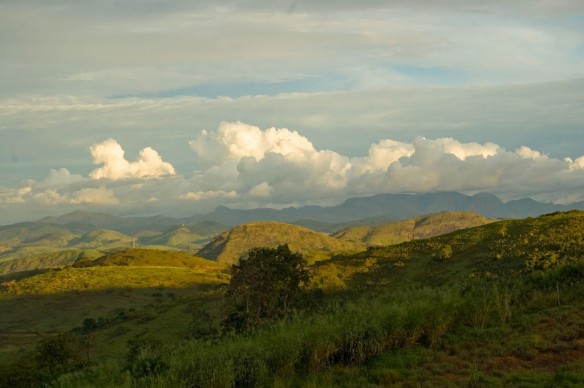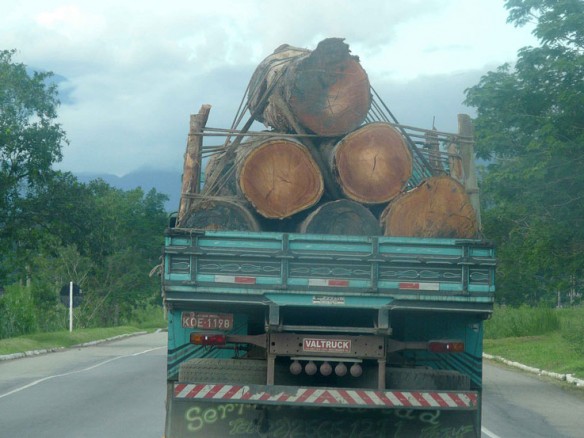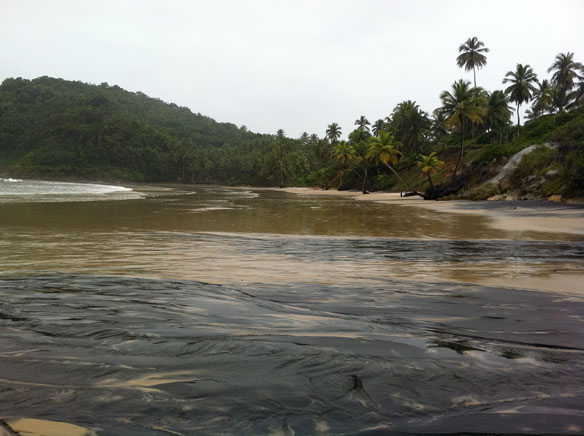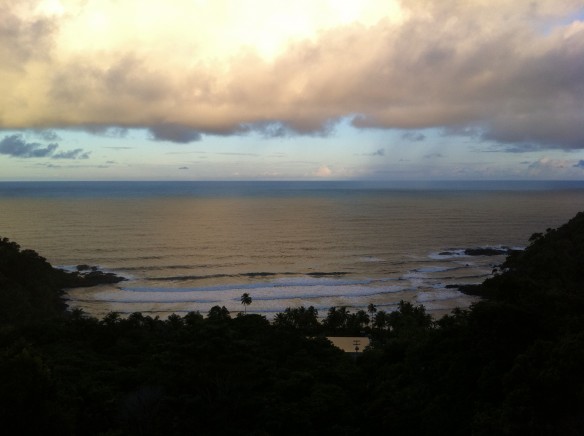
“Last light on denuded hills.” Atlantic Rain Forest Region of Brazil… denuded (Minas Gerais State). Captions and Photo source: ©© Christoph Diewald
Excerpts; from Atlantic Rainforest Organization, UNEP, and OurAmazingPlanet
“It’s the most threatened rainforest in Brazil, a global biodiversity hotspot, and contains around one in 12 of all species on the planet. We must be talking about the Amazon, right? Wrong. It’s the Atlantic Forest, which used to run in a continuous strip along the 2,000 miles of Brazil’s eastern seaboard, up the steep coastal mountain slopes and, in places, far into the interior, reaching parts of Paraguay and northern Argentina. But the story of the Atlantic Forest does not end at the tide line. Its influence extends well out into the coastal waters of Brazil, as the nutrients from the forest flow into the estuaries and bays to form rich feeding grounds for a wide variety of marine creatures.” Tim Hirsch, OurAmazinPlanet
The Amazon forest is thousands of miles from where most Brazilians live, unlike the Atlantic Forest. The later has been right in the path of agricultural and urban development for 500 years, and today 130 million people live within its boundaries.
When European colonists arrived in the 1500s, the atlantic forest extended along Brazil’s entire coastline, covering more than 386,000 sq. miles along the coast, from the state of Rio Grande Do Norte thousands of miles south to Rio Grande Do Sul., and extending into eastern Paraguay and northeastern Argentina.

Atlantic forest, Itacaré, Brazil. Photograph: © SAF — Coastal Care
Now, the Atlantic Forest is a shadow of its former self.
Today, It has lost almost 93 percent of its original size. Less than 7% of that cover remains, in the wake of centuries of forest clearing for agriculture and urban development, with trees felled to produce charcoal and to be used as fuel for iron and raw steel production. For many years, the Upper Parana Atlantic Forest in Paraguay had one of the highest rate of deforestation in Latin America. The forests continue to be transformed into agricultural land without adequate planning.
In Brazil, the Atlantic forest fragmented remains, by centuries of unsustainable use and logging, cover some 28,600 square kilometers. “At this rate, the forest will be gone by 2050,” warned SOS Mata Atlântica Foundation. In a survey released May 26th 2011, the National Institute for Space Research (INPE) along with the SOS Mata Atlântica Foundation, published data from Atlas of the Atlantic Forests Remnants. The data informed the dire situation in 16 out of 17 states for 2008-2010 period.
The Atlantic Forest ecoregion once stretched over 1 million km2 along Brazil’s coast in 13 states, with extensions inland into Eastern Paraguay and the Misiones province in Northeastern Argentina.
“When European colonists arrived in the 1500s, the atlantic forest extended along Brazil’s entire coastline, covering more than 386,000 sq. miles along the coast…Now, the Atlantic Forest is a shadow of its former self.”
The ecoregion contains 2 types of tropical moist broadleaf forests, the coastal and interior Atlantic Forests, and the Araucaria Pine Forest which previously covered a large portion of the Brazilian states of Parana and Santa Catarina and their borders with Argentina. The coastal and interior Atlantic Forests are some of the richest tropical moist forests on Earth, harboring unique collections of species quite distinct from the Amazon. A 1993 survey identified 450 different tree species within one hectare of Atlantic Forests in the Southern Bahia state – one of the highest diversities of tree species reported in the world.
The cities of Rio de Janeiro and Sao Paulo both lie within the forests.
According to a recent analysis from the Global Land Cover Facility of the University of Maryland, NASA, and the organisation Guyra Paraguay, 35% of the Atlantic Forest was lost in Paraguay between 1989 and 2003.
Some of the largest forest remnants of the Atlantic Forest are found in the Upper Parana River watershed in Argentina and Paraguay. These remnants are still large enough to provide habitat for top predators such as the jaguar and the harpy eagle, as well as large herbivores like the South American tapir, deer, and peccaries.
Today only 7% of the original Atlantic Forests cover remains in Brazil, all of it fragmented by centuries of unsustainable use. This fragmentation, coupled with high endemism, makes the Atlantic Forests one of the most endangered rainforests in the world.” ( according to Atlantic Rainforest Organization)

A roadside scene in the Rio de Janeiro State of Brazil. Captions and Photo source: ©© Blake Maybank
Although governments have attempted to controll deforestation to a certain extent, more needs to be done for responsible soy cultivation and sustainable forest management. A stronger commitment is also needed to restore priority forest areas.
Moreover, while there are a number of protected areas in the Atlantic Forest, the majority are reserves in name only. In practice, there is not enough financing for their adequate protection.
Indeed, on May 26th 2011, the survey released by theNational Institute for Space Research (INPE) along with the SOS Mata Atlântica Foundation, was welcomed by the general media, with a priori cheering headlines:
“The rate of deforestation of Brazil’s Atlantic Forest along much of the country’s eastern coast fell by some 55 percent between 2008 and 2010, according to a study released Friday. The reduction can be explained by more stringent laws and better control.”
But, besides the “numbers” as the officials clearly stated: ” The survey proves that the native forest removal continues and the data warns to implement public policies that encourage Biome conservation and restoration.” And added, ” Between 2008 and 2010, the forest, which is the country’s most devastated ecosystem, second only in the world to the forests of Madagascar, lost 32,000 hectares.”
The deforestation rates are going down from previous year… But so are the forest surfaces’, and undoubtly so is the number of remaining trees to be cut down !!!!
32,000 hectares of a vanishing forest, is an astonishing and devastating reality!
The rates of deforestation have been presented as follow:
Period 1985-1990: 466,937 ha
Period 1990-1995: 500,317 ha
Period 1995-2000: 445,952 ha
Period 2000-2005: 174,828 ha
Period 2005-2008: 102,938 ha
Period 2008-2010: 31,195 ha
Furthermore, and corroboratively, earlier in May, the Brazil government announced the creation of an emergency task force to fight deforestation of the Amazon rainforest, after a sharp increase in deforestation in that region was recorded in March and April this year, 2011…

Scattered clouds mingle with the smoke from scores of fires burning near the mouth of the Amazon River in Brazil, Atlantic coast. The fires, most of which are probably agricultural fires people have set on purpose to clear forest, have been marked with red dots. Caption and image: by Jesse Allen, Earth Observatory / NASA.
Restoration and preservation projects have been developped.
As presented by Atlantic Forest Organization’s Website, WWF has a number of restoration projects in the region aimed at returning native forest where it has previously been destroyed or degraded.
Such a protection exist as The Discovery Coast Atlantic Forest Reserves, in the states of Bahia and Espírito Santo, and consists of eight separate protected areas containing 112,000 ha of Atlantic forest and associated shrub (restingas).
WWF is also working on establishing new protected areas and creating “green corridors” to connect isolated tracts of forests.
The defined Objectives are to:
1. Increase WWF institutional presence in the Atlantic Forests, building credibility to act in the region in partnership with government and other NGOs.
2. Carry out specific activities which make information available that can serve as a basis for ecoregional conservation planning.
3. Contribute to the development of an ecoregional conservation plan, with an emphasis on establishment and effective implementation of protected areas.
4. Promote the establishment of new protected areas.
5. Contribute to the effective implementation of protected areas.
Solution
To ensure stable ecosystems and biological processes as well as to preserve viable populations of key endemic species in the long-term, all forest fragments must be preserved, prioritizing action according to forest type, biodiversity, local endemism, size and biological integrity of the forest.

Brazilian coastal forest, Itacaré. Photograph: © SAF — Coastal Care
In addition, these fragments must be strategically linked with forest corridors, which in some cases imply forest rehabilitation. (Atlantic Rainforest).
In a press release, June 5th, 2011, UNEP declared, within the frame of a synthesis unveiled during this year’s World Environment Day (WED) celebrations, Forests in a Green Economy: : ” Investing an additional US$40 billion a year in the forestry sector could halve deforestation rates by 2030, increase rates of tree planting by around 140 per cent by 2050, and catalyze the creation of millions of new jobs according to a report by the UN Environment Programme.
The Green Economy initiative has identified forestry as one of the ten central sectors capable of propelling a transition to a low carbon, resource efficient, employment-generating future if backed by investment and forward-looking policies.
Creative tree planting are promoted to pursue regeneration and recovery, but also increasing engagement from the private sector in these nature-based assets and mobilization by cities and communities across the globe in tree planting efforts, new kinds of smart market mechanisms, ranging from REDD+ to payments for ecosystem services, are emerging.” (UNEP).
…
May the recognized fragility of the Atlantic coastal Forest become the very seed of its salvation…—CLG

Brazilian coastal forest, Itacaré. Photograph: © SAF — Coastal Care
Read Original Article, A Giant Brought to Its Knees
UNEP, Press Release “Economic Benefits of Boosting Funding for Forests”
Restoring South America’s Atlantic forests
Destruction of Brazil’s Atlantic Forest Falls 55%, AFP in TerraDaily
Brazilian Beauty: The Threatened Atlantic Forest, OurAmazingPlanet








